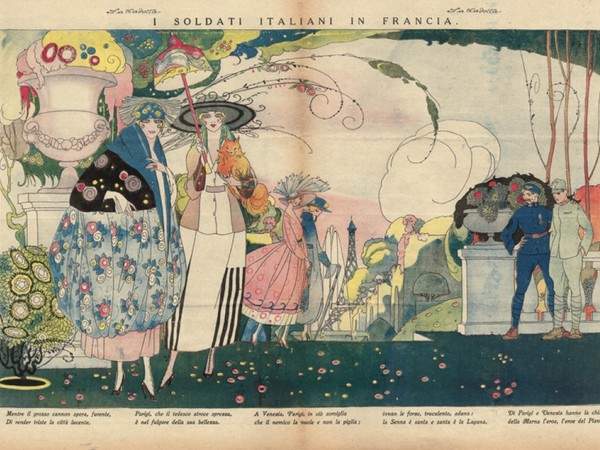The magic of Umberto Brunelleschi, Italian Art Deco genius, celebrated with an exhibition in Montemurlo
Umberto Brun elleschi (Montemurlo, 1879 - Paris, 1949) represents the Italian genius ofArt Deco: now the great Tuscan artist is being honored by an exhibition, titled The Magic of Umberto Brunelleschi, held at the Centro Giovani in Montemurlo, his hometown in the province of Prato. The exhibition, curated by Giorgio Bacci and Alessia Cecconi, is staged on the occasion of the 140th anniversary of his birth and the 70th anniversary of his death and is scheduled from April 6 to June 2, 2019. The initiative, promoted in collaboration with the CDSE Foundation, aims to recover the figure of Brunelleschi, an illustrator of international stature whose work has been rightly brought to light by scholars since the 1990s.
The exhibition traces the evolution of Umberto Brunelleschi. Divided into two large rooms, it presents heterogeneous materials, underscoring the artist’s ideational talent and versatility. The title of the exhibition is meant to evoke his rare and refined art, which is revealed in the covers and illustrations of the great French magazines such as those of the Giornalino della Domenica and La Lettura del Corriere della Sera, in the dreamy drawings of children’s books, but also in the theatrical sets and stage clothes of Turandot , which was performed at the Maggio Musicale Fiorentino in 1940.
In Florence Brunelleschi attended theAcademy of Fine Arts; decisive was his meeting, at the Scuola libera del nudo, with Ardengo Soffici and Giovanni Costetti. It is with them that he decides to move to Paris. In the French capital, the real change of pace takes place: the artist opens up to an international dimension, hanging out with artists of the caliber of André Derain, Amedeo Modigliani, Pablo Picasso, or literary figures such as Gabriele D’Annunzio. Brunelleschi defined his own immediately recognizable style over the years, masterfully employing a precious and refined technique such as pochoir (examples of which are on display in the exhibition), and he was among the few artists of international caliber to reach the qualitative level of such great Deco draftsmen as Georges Lepape and George Barbier. The artist in France meets with growing favor, illustrates numerous volumes, and his work is in demand by the most important fashion and costume periodicals.
In Italy he illustrates children’s books, collaborates with La Lettura del Corriere della Sera and Il Giornalino della Domenica. He made his debut in 1915 at the Pergola in Florence, was engaged at La Scala in Milan, in several productions, from 1918 to 1938. Finally, he created the sets and figurines for the version of Turandot performed in 1940 at the Teatro del Maggio Musicale Fiorentino.
The original drawings for L’albero delle fiabe (1909), a collection of fairy tales by Massimo Bontempelli, highlight a style in the making, still in search of its precise identity. However, the visitor will easily discern in them that predilection for a careful and well-calibrated graphic linearism that will return, mature and relaxed, in the masterpiece Le malheureux petit voyage (by Gabriel Soulages, 1926), also exhibited on a par with Les contes de Boccace (1934), Zufrin (by Giuseppe Fanciulli, 1932), and La cronaca della settimana (by Luigi Bertelli, 1921).
The magazine sector, central to Brunelleschi’s fortunes, is well represented by a series of covers elaborated in 1908 for Il giornalino della Domenica,dedicated to the seasons of the year: a winter landscape caressed by snow (January) dialogues with the fairy-tale atmosphere of a pond illuminated by the moon and stars (June), or children engaged in seaside games (August) respond to the little one bundled up among the bare trees (November). Another important periodical also availed itself of Brunelleschi’s collaboration: it is La Lettura, linked (then as now) to the Corriere della Sera. On display are espostenumerose covers. From the charming pen-point portrait of June 1926 to the chinoiserie of September 1924, from the mask of February 1920 to the refined arabesque drawing of July 1923.
A separate role for La Tradotta, weekly newspaper of the Third Army, edited by Renato Simoni, which Brunelleschi illustrated on several occasions in 1918, elaborating images with a winking tone. Events become expedients to depict improbable harems and figurines, gallant scenes and transparent allegories. The exhibition also features an installation that aims to bring into dialogue, for the first time, the stage sketches and figurines made by Umberto Brunelleschi for the Turandot performed at the Maggio musicale fiorentino in 1940, with the costumes actually made on that occasion. Visitors will be able to admire the original designs alongside sumptuous dresses, in which gold and silk dragons come to life.
The exhibition, which will remain open until June 2, is sponsored by the City of Montemurlo in collaboration with the CDSE Foundation, the Giunti Editore Historical Archives, the Historical Archives of the Maggio Musicale Fiorentino Theater, the National Central Library of Florence Foundation, the Cerratelli Foundation, the Lazzerini Cultural and Documentation Institute, and the Soprintendenza Archeologia, Belle Arti e Paesaggio of Florence, Pistoia and Prato. The project has the patronage of the City of Florence and is realized with the support of Fondazione Cassa di Risparmio di Prato and Fondazione BCC. For all information you can call +39 0574 558567 or visit www.comune.montemurlo.po.it
Pictured: an illustration by Umberto Brunelleschi
Source: press release
 |
| The magic of Umberto Brunelleschi, Italian Art Deco genius, celebrated with an exhibition in Montemurlo |
Warning: the translation into English of the original Italian article was created using automatic tools. We undertake to review all articles, but we do not guarantee the total absence of inaccuracies in the translation due to the program. You can find the original by clicking on the ITA button. If you find any mistake,please contact us.



























